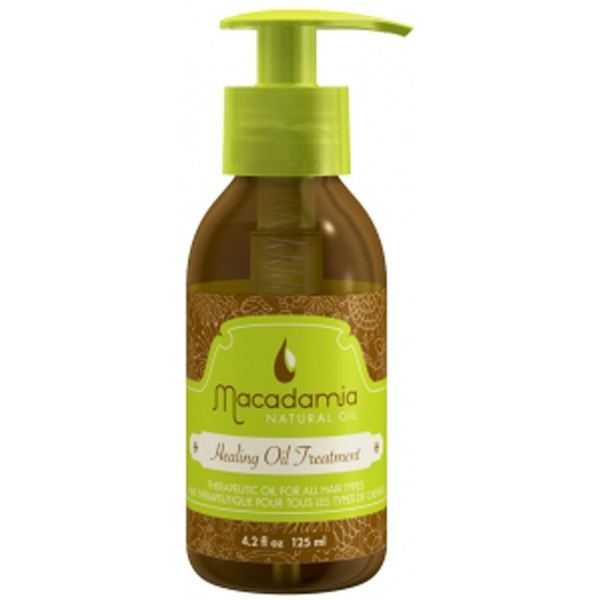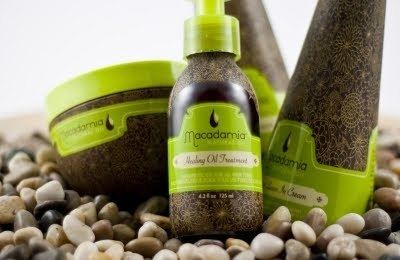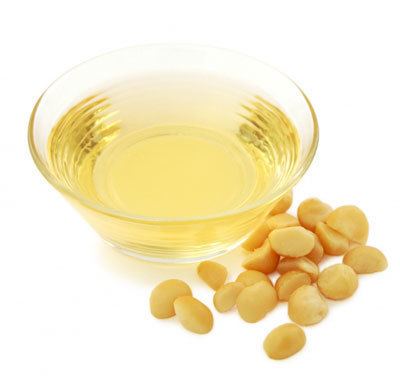Similar Macadamia, Avocado oil, Seed oil, Argan oil, Jojoba | ||
Macadamia oil (or macadamia nut oil) is the non-volatile oil expressed from the nut meat of the macadamia (Macadamia integrifolia) tree, a native Australian nut. Macadamia oil is sometimes used in food as a frying or salad oil, and in cosmetic formulations as an emollient or fragrance fixative.
Contents

Physical properties

Macadamia nuts contain over 75% of their weight as oil, the remainder is: 9.0% proteins, 9.3% carbohydrates, 1.5% moisture, 1.6% mineral matters and 2.0% fiber. The kernels of macadamia contain vitamin A1, B1, B2, niacin and essential elements such as calcium, iron, phosphorus, magnesium and potassium. The oil is a triglyceride oil and contains primarily monounsaturated fats up to 80-84%. Macadamia oil contains the highest percentage of monounsaturates when compared to both olive and canola oils (www.macnut.co.nz ).

Macadamia integrifolia is an Australian tree with holly-like leaves that grows well in a moist organic soil and will survive temperatures of 24 °F. Seedlings bear in 5–7 years. The fruit is borne in a case enclosing an extremely hard spherical nut. The kernel is whitish, sweet and eaten raw or roasted. The flowers are white to cream and the leaves are in whorls of three. Propagation is by seed, grafting or air layering. It is grown commercially.

Common names of the trees are, Australian nut and Queensland nut. Species are “smooth shelled macadamia” called Macadamia integrifolia and “rough shelled macadamia” called Macadamia tetraphylla. Macadamia ternifolia is also the name used for M. integrifolia. Macadamia integrifolia is native to Australia where it grows in rain forests and close to streams. Macadamia tetraphylla is native to Southeastern Queensland and Northeastern New South Wales. The oil content ranges from 65% to 75% and sugar content ranges from 6% to 8%. These factors result in variable colors and texture when the nuts are roasted under the same conditions (www.crfg.org).

Macadamia oil is liquid at room temperature. The refined oil is clear, lightly amber-colored with a slightly nutty smell. It has a specific gravity of 900-920 and a flash point of over 300OC.
Oil accumulation does not commence until the nuts are fully grown and the shell hardens. It accumulates rapidly in the kernel during late summer when the reducing sugar content decreases. The composition of mature, roasted and salted macadamia nuts is shown. As with many oil seeds, the protein is low in methionine. Fresh kernels contain up to 4.6% sugar, mostly non-reducing sugar. The oil consists of mainly unsaturated fatty acids and is similar in both species, although the proportion of unsaturated to saturated fatty acids appears to be slightly higher in M. integrifolia (6.2:1 compared with 4.8:1). The fatty acid composition and the absence of cholesterol may lead to the promotion of macadamias as a high-energy health food. The major volatile components in roasted macadamia kernels are apparently similar to those found in other roasted nuts, although little detailed information is available.
Nutritive value (g/100g) of macadamia nuts roasted in oil and salted.
Chemical makeup
Macadamia oil contains approximately 60% oleic acid, 19% palmitoleic acid, 1-3% linoleic acid and 1-2% α-linolenic acid. Some varieties contain roughly equal omega-6 and omega-3. Although macadamia is cultivated in many different parts of the world, the oil's fatty acid profile is not greatly influenced by environmental factors. The oil displays chemical properties typical of a vegetable triglyceride oil. It is also very stable due to its low polyunsaturated fat content.
Uses in food
Macadamia oil can be used for frying due to its high heat capacity along with other properties useful as an edible oil:
This is a comparison chart of some of the more common vegetable oils:
Uses in cosmetics
Palmitoleic acid at such a high concentration is rarely found in vegetable oils. This fatty acid is mostly found in fish oils. Palmitoleic acid is found in macadamia oil in concentrations as high as 21% (Ako et al., 1995). Derivatives of macadamia oil in cosmetics include the light emollient ethyl macadamiate and water-soluble PEG-16 macadamia glycerides.
Polarity of the oil phase has a great influence on the formulation and properties of the cosmetic emulsions. Polarity of the oil phase is considered as an essential factor for the stability of water-in-oil emulsions (Dietz 1999a). Polarity of macadamia nut oil was found to be 525.50 nm±0.29 nm (SE). This is considered as highly polar. Polar oils may enhance solubility of oil soluble cosmetic ingredients. Heat stability of emulsions prepared with strongly polar and non-polar oils were found to give emulsions with poor stability which is generally experienced with natural oils. (Dietz 1999a)
Macadamia oil is an excellent botanical replacement for mink oil in most applications. It is also used for hair.
Macadamia oil's INCI name is macadamia ternifolia seed oil. CAS Numbers: 128497-20-1
